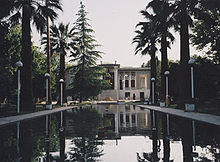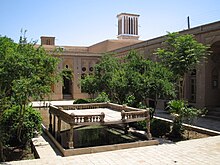Persian garden
The term Persian Gardens refers to formal palace or pleasure gardens of the Middle Ages and modern times in Iran and neighboring regions. There are also mostly irrigated vegetable gardens and orchards in Persia, which, however, do not fall under this term. Garden design is a fundamental part of Persian culture . This had such an effect that the old Persian term for garden Paradaidha as " paradise " was borrowed in many European languages as well as in Hebrew, where the term Pardes is still used today. In June 2011, nine Persian Gardens were declared a World Heritage Site by UNESCO .
The elements of the Persian garden

In Persian gardens , inner court gardens are often connected to external gardens by structures such as arches. The inner gardens are intended to act as a symbol of the domestic, while the outer gardens reflect the surrounding world. Such a garden is primarily used for recreation and relaxation. Furthermore, a garden is used as a place for spirituality , social activities, and previously also as a place for a feast, etc. A Persian garden can be formally laid out, i. H. the structure of the garden is of particular importance, or with a focus on the flora.
sunlight
An important factor in the structural design in Persian gardens are sunlight and light effects. Architects tame sunlight by creating patterns and shapes from the light rays.
shadow
Due to the hot climate in Iran, shady areas are desirable in the gardens. Trees and bushes provide natural shade, and pavilions and walls are often used to protect against strong sun. Experienced architects create special effects through shadow play.
water
Since there are very dry areas in addition to the many forests in Iran, water is particularly important. Qanats or springs water the entire garden. It is believed that the technology of the qanats, the tunnels of which run beneath the water table, is several thousand years old. The garden itself is also often criss-crossed by water channels. Such can be found in the garden type Tschahār Bāgh . Trees are often planted in water-filled trenches, called dschub , which prevent evaporation and provide the tree roots with sufficient water.
building
In addition to arches, masonry and magnificent buildings, there are pavilions in many gardens. Their originally Persian name (كوشك, DMG kūšk , also pronounced kōschk ) has found its way into German as a “ kiosk ”.
Garden types
After the Arab conquest , the waterways of the inward-facing and always walled variant of Persian gardens were interpreted as a symbol of the paradisiacal rivers that carry water and wine, milk and honey. This type of garden was often copied from the gardens of the Spanish Moors to the Mughal gardens in India with the spread of Islam .
Only a few old gardens have been preserved. Bagh-e Schahsadeh , which since its creation in 1873 to the palace of Prince Abdul Hamid Mirza of Qajar leads dynasty, shows how the Persian Garden acts in particular by the contrast to its dry environment.
The six basic types of the Persian garden are listed in the following list according to type and function. However, Persian gardens are not always limited to one type, but often combine different types.
- Hajat
- Public Hajats are classically designed with a special focus on aesthetics, while function is rather neglected. Buildings are important in this type. Arches and pools of water complement the natural growth of the garden. The ground is usually covered with gravel. The planting is usually very simple. For example, simple rows of trees provide shade.
Private Hajats often have a pool of water in their midst . This serves as a focal point and a moisturizer. Here, too, the flora is rather simple. - Meidan
- This public garden places more emphasis on the natural elements than the Hajat and minimizes structural elements. The plant species are diverse. Trees, bushes and flowers are surrounded by grass. Here, too, gravel paths lead through the green areas to water basins. Occasionally, pavilions also provide protection from the strong sun.
- Tschāhār Bāgh
- Cyrus the Great is traditionally considered to be the inventor of the Tschāhār-Bāgh type. These gardens are defined by their structure. They consist of four quadrants that are separated by paths or watercourses. In these gardens the relationship between building and green is balanced. Plants surround water basins, paths or canals. Traditionally, Tschāhār-Bāgh gardens have a representative function.
- park
- The Persian Park offers the public a rich flora. Structural elements hardly appear, because the function of a park is primarily relaxation. This type of garden is comparable to European parks.
- Bagh
- This type of garden is quite similar to the park, but mostly belongs to private houses. It is used for family recreation and consists of lawns, trees, flower beds, and occasionally watercourses. Bagh is comparable to European home gardens.
History of the Persian garden culture

Achaemenids
The oldest preserved Persian palace garden goes back to Cyrus II . His remains were found in Pasargadae in Fars . This garden had a rectangular plan and stone-lined canals. It also had a pavilion.
Xenophon reports how the Spartan Lysander around 400 BC Came to Sardis as ambassador and admired the garden of the Persian Prince Cyrus the Younger there . Cyrus is said to have received his guest personally and assured him that he had laid out and planted the garden himself.
Sasanids
During the Sassanid rule from the 3rd to the 7th centuries and under the influence of Zoroastrianism , water, represented as fountains and lakes in the gardens, was of outstanding importance in art.
Ardaschir I (226–240 AD), the first Sasanid ruler, laid out a walled garden in Firuzabad with a circular lake in the center. It was famous for its numerous types of roses and fruit trees. In the palace of Chosrau I (531-579) in Ctesiphon there was a carpet called Bahār-e Kisra , which depicted a royal garden. It was 137 m long and 28 m wide. Canals divided flowering meadows lined with flowering fruit trees. The whole thing was surrounded by a discount. The underground consisted of gold brocade, the leaves were woven in green silk, precious and semi-precious stones represented the flowers, and rock crystal was used for the water. Its appearance has been passed down through Arabic authors such as Tabari . Otherwise, no Sasanian garden plan has survived.
middle Ages
After the Arab storm, the Persian garden became a symbol of the Islamic paradise. Due to the Islamic expansion , the Persian garden became widespread, which is why the term "oriental" garden is used today. The descriptions of love scenes or drinking bouts in gardens by Persian poets such as Nezāmi show the importance attached to the garden.
The Mongol invasion in the 13th century increased the architectural ornamentation in the garden. India was strongly influenced by the Mughal rule , the Mughal Gardens have forerunners in Central Asia and Afghanistan. Persian carpets often depict stylized garden motifs. The carpet borders symbolize border walls and paths. The inner carpet surface is usually divided into quarters, which in turn contain six squares. These are decorated with flower patterns or stylized trees. The oldest descriptions and drawings of Persian gardens come from travelers, Ibn Battuta in the 14th century, Ruy González de Clavijo in the following century and Engelbert Kaempfer in the 17th century.
Marco Polo described Persian gardens as a paradise, planted with the best fruits in the world and crisscrossed by four canals: Wine flows through one of these canals, one with milk, one filled with honey and one with water.
Safavids
During the Safavid dynasty (17th to 18th centuries) palace gardens of enormous dimensions were laid out. These gardens were aesthetic and functional parts of palace complexes.
Engelbert Kämper drew Safavid gardens precisely and published them in Europe. They show the garden type Tschahar Bagh with an enclosing wall, rectangular water basins, a network of canals inside the garden and pavilions.
In the centuries that followed, European garden design began to influence Iran, especially French garden types , but Russian and British gardens also became role models. New types of irrigation and new bedding plants are due to the influence of the West.
present
The traditional garden forms and types are no longer common in Iran. They can only be admired in museums and historical places. Sections of the rich population still maintain traditional gardens.
In 2011, nine gardens were declared a World Heritage Site by Unesco:
- Mahan-e Kerman
- Abbas Abad in Behshar
- Bagh-e Fin in Kashan
- Tschehel Sotun in Isfahan
- Bagh-e Eram in Shiraz
- Gardens of Pasargadae in Shiraz
- Doulat Abad in Yazd
- Pahlewan Pur in Jazd
- Akbarieh Birdschand
reception

The Median word for garden found its way into Judeo-Christian mythology as a name for paradise .
Babur introduced the Central Asian Timurid Garden in India . The no longer maintained garden of Aram Bagh in Agra was the first of many gardens that he created. The Persian ideal of a paradise garden was realized in the grounds of the Taj Mahal .
Garden scenes are typical for Persian literature , for the art of carpet-making , for Persian architecture, but also for Persian painting. For example, large parts of Nezāmi's love epics are set in gardens. Hafez's poems use garden flowers as a stylistic device.
Goethe writes about Persian gardens:
“Dig your field in a neatly clean area,
That the sun will gladly shine on the industry;
When you plant trees, so be it in rows,
for it lets things flourish.
Even the water in canals should
never be short of run or clean. "
Nowadays the Persian garden has almost been forgotten under the gross simplification of the "oriental" garden.
Famous Persian gardens
- Bagh-e Eram in Shiraz
- Bagh-e Schahzadeh in Kerman
- Bagh-e Fin in Kashan
- Bāghtscheh Jugh in Maku
- Doulatabad in Yazd
- Niāvarān in Tehran
- Saad Abād in Tehran
- Taj Mahal
- Tschehel Sotun in Isfahan
See also
literature
- Penelope Hobhouse : Persian Gardens. Paradise of the Orient . Knesebeck, Munich 2005, ISBN 3-89660-271-3 .
- Donald Newton Wilber: Persian Gardens and Garden Pavilions . Charles E Tuttle, Rutland (Vermont) / Tokyo 1962; New edition: Dumbarton Oaks Research Library and Collection, 1979.
Web links
- The Persian Garden on the UNESCO World Heritage Center website ( English and French ).
- A history of Persian gardens. GardenVisit.com ( Memento from December 6, 2012 in the web archive archive.today ).
- James Dickie: The Mughal Garden: Gateway to Paradise. In: Oleg Grabar (ed.): Muqarnas: An Annual on Islamic Art and Architecture 3. EJ Brill, Leiden 1985, pp. 128-137 (PDF).
- bāḡ (bagh) “garden”. Entry in the Encyclopaedia Iranica .
- Lisa Golombek: Garden - II. Islamic Period. Article in Encyclopaedia Iranica, December 2000.
Individual evidence
- ↑ 25 new World Heritage Sites. Press release, June 28, 2011 ( Memento from September 14, 2012 in the web archive archive.today ). German UNESCO Commission.
- ↑ Xenophon, Oikonomikós , IV.20 ff.
- ↑ cf. The Persian Garden on the UNESCO World Heritage Center website ( English and French ).
- ↑ León Rodríguez Zahar: Imágenes del paraíso en los jardines islámicos. In: Estudios de Asia y Africa. 1999, Vol. 34, No. 2 (109), p. 367.
- ^ Martin Conway: A Persian Garden Carpet. In: The Burlington Magazine for Connoisseurs. 1913, Vol. 23, No. 122, p. 95.
- ^ Martin Conway: A Persian Garden Carpet, 1913, p. 96.
- ^ The Persian Garden: Locations. UNESCO World Heritage Center website.




